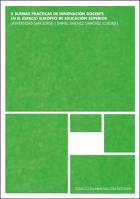Por favor, use este identificador para citar o enlazar este ítem:
https://repositorio.usj.es/handle/123456789/924
Registro completo de metadatos
| Campo DC | Valor | Lengua/Idioma |
|---|---|---|
| dc.contributor.author | Vergara Rodríguez, Diego | - |
| dc.contributor.author | Sánchez-Prieto, Montserrat | - |
| dc.contributor.author | Sánchez-Calvo, María | - |
| dc.contributor.author | Nieto-Sobrino, María | - |
| dc.contributor.author | Gómez-Vallecillo, Ana Isabel | - |
| dc.contributor.author | Fernández-Arias, Pablo | - |
| dc.contributor.author | Antón-Sancho, Álvaro | - |
| dc.date.accessioned | 2023-05-30T11:30:36Z | - |
| dc.date.available | 2023-05-30T11:30:36Z | - |
| dc.date.issued | 2023 | - |
| dc.identifier.citation | Vergara Rodríguez, D., Sánchez-Prieto, M., Sánchez-Calvo, M., Nieto-Sobrino. M., Gómez-Vallecillo, A. I., Fernández-Arias, P. y Antón-Sancho, A. (2023). Implementación del visual thinking en Bachillerato: una experiencia de innovación docente. En D. Jiménez-Sánchez (Coord.), Buenas Prácticas de Innovación Docente en el Espacio Europeo de Educación Superior (vol. X) (pp. 84-102). Ediciones de la Universidad San Jorge. https://doi.org/10.54391/123456789/924 | en_US |
| dc.identifier.uri | https://repositorio.usj.es/handle/123456789/924 | - |
| dc.description | Visual Thinking (VT) represents an innovative didactic methodology that, by using graphic resources, facilitates the teaching-learning process by developing a global vision of the contents, enhancing students’ creativity and analytical and synthetic skills. This work is based on the implementation of VT methodological techniques in Industrial Technology classes in the 2nd year of Bachillerato, developing the design of advanced didactic contents by teachers and students. It was also necessary to analyze the type of assessment that both teachers and students made of the application of VT to the reality of the classroom. For this purpose, the selected students, from 2nd Bachillerato, formed an Experimental Group (EG), as opposed to another Control Group (CG) made up of students in the 1st year of Compulsory Secondary Education. With all this in mind, this article carries out quantitative research on the potential of VT as an element favoring the teaching-learning process. The results obtained show that this methodology develops in the students a more motivating and creative learning, improving their analytical and organizational skills. On the other hand, teachers recognize that VT favors the synthesis of contents, improves memorization, attention, and concentration of their students, valuing the methodology as an educational proposal, of a transforming nature, based on constructivism. | en_US |
| dc.description.abstract | El Pensamiento Visual, o Visual Thinking (VT), representa una metodología didáctica innovadora que, utilizando recursos gráficos, facilita el proceso de enseñanza-aprendizaje al desarrollar una visión global de los contenidos, potenciando en el alumnado la creatividad y las capacidades analítica y sintética. Este trabajo se basa en la implementación de técnicas metodológicas de VT en las clases de Tecnología Industrial de 2º curso de Bachillerato, desarrollando el diseño de contenidos didácticos avanzados por parte de docentes y alumnos. Se planteó, además, la necesidad de analizar el tipo de valoración que, tanto profesores como estudiantes, realizan de la aplicación del VT a la realidad del aula. Para ello, los alumnos seleccionados, de 2º Bachillerato, conformaron un Grupo Experimental (GE), frente a otro Grupo de Control (GC) integrado por alumnos de 1er curso de Educación Secundaria Obligatoria. Con todo ello, en este artículo se realiza una investigación cuantitativa sobre el potencial del VT como elemento favorecedor del proceso de enseñanza-aprendizaje. Los resultados obtenidos demuestran que esta metodología desarrolla en los discentes un aprendizaje más motivador y creativo, mejorando sus capacidades de análisis y de organización. Por otro lado, los docentes reconocen que el VT favorece la síntesis de los contenidos, mejora la memorización, atención y concentración de sus alumnos, valorando la metodología como una propuesta educativa, de carácter transformador, basada en el constructivismo. | en_US |
| dc.format.mimetype | application/pdf | en_US |
| dc.language.iso | spa | en_US |
| dc.language.iso | eng | en_US |
| dc.publisher | Universidad San Jorge | en_US |
| dc.relation.requires | Adobe pdf | en_US |
| dc.rights | Attribution-NonCommercial-NoDerivatives 4.0 Internacional | * |
| dc.rights.uri | http://creativecommons.org/licenses/by-nc-nd/4.0/ | * |
| dc.subject | Visual thinking | en_US |
| dc.subject | Metodologías | en_US |
| dc.subject | Enseñanza-aprendizaje | en_US |
| dc.subject | Creatividad | en_US |
| dc.subject | Motivación | en_US |
| dc.subject | Methodologies | en_US |
| dc.subject | Teaching-learning process | en_US |
| dc.subject | Creativity | en_US |
| dc.subject | Motivation | en_US |
| dc.title | Implementación del visual thinking en bachillerato: una experiencia de innovación docente | en_US |
| dc.type | info:eu-repo/semantics/bookPart | en_US |
| dc.identifier.publicationfirstpage | 84 | en_US |
| dc.identifier.publicationlastpage | 102 | en_US |
| dc.identifier.doi | 10.54391/123456789/924 | - |
| dc.rights.accessrights | info:eu-repo/semantics/openAccess | en_US |
| Aparece en las colecciones: | Capítulos de libros | |
Ficheros en este ítem:
| Fichero | Descripción | Tamaño | Formato | |
|---|---|---|---|---|
| Implementación del visual thinking en bachillerato una experiencia de innovación docente.pdf | 1,32 MB | Adobe PDF |  Visualizar/Abrir |
Este ítem está sujeto a una licencia Creative Commons Licencia Creative Commons

